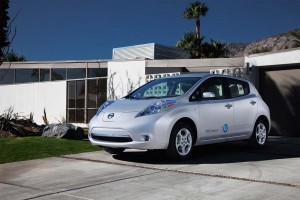Nissan aims to address two of the most common concerns about its Leaf battery-electric vehicle, range and price, with a series of updates that will extend driving distance and lower the cost on a new, stripped-down model.
The announcement in Tokyo, earlier today, focused on versions of the Leaf sold only in the Japanese home market. But Nissan plans to take similar steps in the U.S., as well. A new entry-level version of the Leaf will reach American showrooms next year while all U.S. versions will likely also see range extended as Nissan continues to evolve the breakthrough battery-cars electric drivetrain.
“People who try out the Leaf are moved,” said Nissan Senior Vice President Masaaki Nishizawa. “But they are worried about cruise range.”
In Japanese trim, the updated Leaf will now get 142 miles per charge compared with 124 miles before. Range is a highly subjective number and depends heavily on driving conditions including weather. Operating a vehicle like the Leaf at highway speeds on a cold day significantly reduces the distance it can travel between charges.
The U.S. Environmental Protection Agency, which oversees fuel economy ratings, uses a different test process from Japan. In the States, the Leaf is rated at 73 miles per charge. If it gets the same 15% bump as the Japanese model that would translate into at least 83 miles once the update comes to the States.
As for the new entry-level model, it loses some of the higher-end features not typically found in comparably sized mainstream cars running on gasoline, a Nissan source explained. In Japan, that will allow Nissan to reduce the base price to the equivalent of $31,000 – after government clean-car subsidies – down from $37,000 with the outgoing base model.
Some of the changes helping Nissan lower costs won’t be missed — or even seen – by consumers, however. The maker says it was able to reduce the use of expensive rare earth metals in the Leaf’s electric motors by 40%.
Meanwhile, other improvements will be visible on the updated model:
- A downsized charging system makes room for more cargo space in the trunk;
- The updated navigation system not only can plot out the fastest way to your destination but also the route that will use the least energy;
- The battery charging model is now smaller and lighter.
The Nissan Leaf is now the world’s best-selling battery-electric vehicle, with 43,000 sold since the BEVs introduction in late 2010. Demand has been down sharply in the U.S. market most of the year, however, forcing CEO Carlos Ghosn to last week acknowledge that his original 2012 target “will not be reached.”
Sales began rebounding last month, however, October 2012 volume up 86%, year-over-year, to 1,579 in the U.S.
Nissan officials have suggested sales will likely grow markedly after production begins on a new Leaf assembly line in Smyrna, Tennessee next month. The new entry model due in mid-2013 should also help boost sales in the U.S., they contend.
But Nissan will be facing a wave of new competitors that include the first battery electric models from Toyota, Honda and Chevrolet, among others, as well as an assortment of plug-in hybrid electric vehicles, or PHEVs. The Chevrolet Volt plug-in has generally been seen as the biggest challenger to the Leaf. While PHEVs are more expensive and don’t offer the same battery range they do offer a gas engine backup for longer trips.

